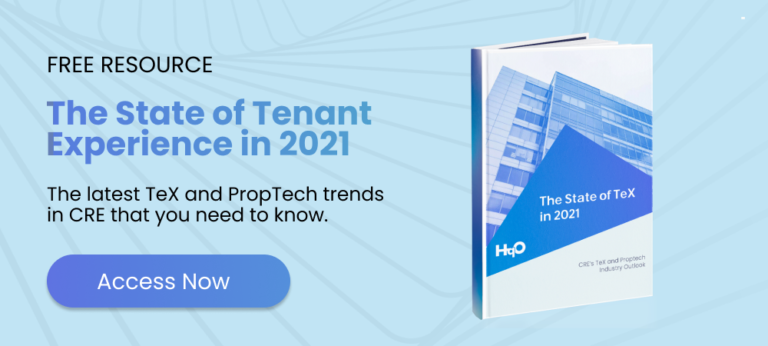It’s no secret that commercial real estate data and trends have been evolving at a breakneck pace. In our commercial real estate outlook 2020, commercial property data was just beginning to indicate a wave of unprecedented change for the market. The more the workforce was forced out of the public realm due to global events, the more technology and tech-enabled businesses prospered. Thus, the technological innovation of office buildings has become a centerpiece of discussion for landlords and property teams who are looking to triumph over the inevitable ebbs and flows of a recently disrupted market.
When it comes to the most recent commercial real estate data analytics, what emerging trends can we look forward to and prepare for? Below are just a few themes we bring to light in our commercial real estate outlook 2021, The State of Tenant Experience:
Attracting Tenants and Flight to Quality
Attracting tenants is one of the more urgent considerations for property teams. According to the most recent commercial real estate market statistics, tech-enabled, highly amenitized buildings are the offices tenants want to come back to. In the same vein, CRE leaders will amass a whole new set of challenges over the next decade if they don’t start to make necessary, aggressive changes to how they appeal to and support younger generations in the workplace.
Additionally, the average age of a CRE professional is in the 50s, yet millennials already make up 50% of the workforce. By 2025, millennials are projected to reach a staggering 75% of the global workforce. This means that the industry as a whole will need to prioritize attracting younger talent in order to survive. Without establishing modern work experiences and tools, CRE won’t be able to engage with the younger, digital-native generations or their tech-savvy skill sets.
Shifts in Cap Rates
Blending physical and digital office experiences to become an omnichannel workplace will generate value in many ways. Due to the current influx of remote and hybrid work models, CRE offerings can no longer just be an office building. Many workplace cultures around the globe have already extended beyond physical infrastructure to open up digital integrations, programming, and engagement possibilities for companies and their employees. Now, landlords need to meet the needs of leading employers with tech-enabled workplace solutions that also serve as real estate data providers. Those that do will command low capitalization rates, and those that don’t will be left behind.
Systems Interoperability
Due to the need for omnichannel office experiences, tenants are looking for partners that deliver spaces and experiences that drive productivity and employee satisfaction, no matter where they work. They also require the right technical support and expertise to help alleviate the burdens commonly associated with determining how to make office buildings and various technologies mesh. To address these concerns, property teams need to create efficiencies in the procurement process.
With so many products and providers to choose from, there are risks including expensive procurement activity, fragmented implementation, inefficient switching costs, and buyers’ remorse. Among all the risks and options, how do you effectively make the right decision? Ultimately, property teams will require the right technology and commercial real estate data sources to help walk them through the implementation and management of various technology solutions, as well as to provide ongoing consultation and support to ensure faster innovations throughout any portfolio — and at any scale.
New Flexibility Rules
Many companies have been forced to figure out how to function without the physical office for the time being, which has accelerated a mass investment into digital infrastructure for company communication and collaboration. While such tools may not capture the full value of in-person engagement, they are only a fraction of the cost of physical space — forcing landlords to answer the questions, “What is the return on investment (ROI) of leasing space at one of our properties?” and “How can I be sure that I’m capturing the right commercial real estate insights?”
With digital alternatives to the office building, landlords cannot rely solely on the contractual obligation of a long-term lease in achieving customer retention or to prove commercial property value. Moving forward, they will need to win customer loyalty by providing excellent customer experiences. Property owners must start the process of change management in order to adopt a more tech- and data-enabled mindset, which in turn helps bring new generations and their skills in-house. At the same time, they need to start becoming a technology provider for their customers to create efficient and unique digital-to-physical experiences. These factors combine the right talent with the right data needed to maintain long-term customer commitments and keep portfolios afloat.
Discover the Future of Commercial Real Estate
To help address some of the major 2021 trends, owners and property teams need to take advantage of the abundance of big data in commercial real estate that can revolutionize any office portfolio. Competitively leveraging this data requires the right commercial real estate tools to become data-driven decision makers. Advanced analytics offerings — such as the HqOS Digital Grid™ — can help create a commercial property owners’ database that contributes to predictive analytics, benchmarking capabilities, and more personalized experiences for the tenants who make up a modern workforce.
To learn more about what will guarantee success for CRE leaders in the foreseeable future, download a free copy of our 2021 Industry Outlook today!




